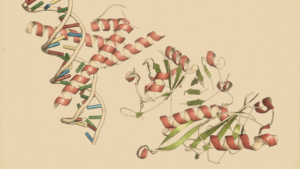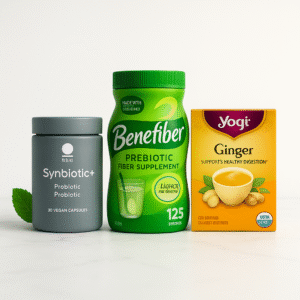Synbiotics 101: The Future of Gastrointestinal Health
Dive into the world of synbiotics and uncover their transformative potential for gastrointestinal health. Learn about blend of probiotics and prebiotics

Synbiotics, a blend of live microbes and beneficial substrates, hold promise for better gastrointestinal health.
Formulating these mixtures is tough because of a lack of strategies to test their efficacy before trials.
Synbiotics come in two types: complementary and synergistic.
The more common complementary synbiotics combine probiotics and prebiotics, with each element acting separately, yet jointly offering health advantages.
Synergistic synbiotics, on the other hand, involve a microbe that's specifically activated or boosted by its paired substrate.
While the concept is exciting, fewer studies have explored its synergy.
Key Points
- Synbiotics Overview: Synbiotics are combinations of live microbes and beneficial substrates. They are classified into two main types: complementary and synergistic. Complementary synbiotics combine probiotics and prebiotics, each offering distinct health benefits, while synergistic synbiotics involve a specific microbe activated or enhanced by its paired substrate.
- Gut Microbiome's Role: The gut microbiome plays a significant role in human health, influencing digestion, energy production, immunity, and more. Factors like antibiotics, diet, and stress can disrupt this microbial balance, leading to potential health complications.
- Challenges with Probiotics and Prebiotics: Despite the known benefits of probiotics and prebiotics, achieving consistent positive results in clinical settings is complex due to the vast diversity of probiotic strains, varied prebiotic structures, and the intricate ecological dynamics within the gut.
- Rise in Synbiotic Popularity: Over the past decade, there has been a marked increase in consumer interest in synbiotics. They have witnessed growing representation in the food and supplement market, with sales nearing $1 billion, indicating their potential health and commercial significance.
- Formulation and Testing of Synbiotics: Crafting effective synbiotic combinations involves rigorous scientific strategies, both pre-clinical and clinical. Innovations like In Vivo Selection, In Vitro Enrichment, and matching phenotypic-genotypic properties are paving the way for refining synbiotic formulations and ensuring their efficacy in promoting health.
In This Article:
Harnessing the Gut for Better Health
Recent studies spotlight the gut microbiome's significant role in human health A Trusted Source Fan, Y., and Pedersen, O. (2020). Gut microbiota in human metabolic health and disease.Nat. Rev. Microbiol.2020, 55–71. doi: 10.1038/s41579-020-0433-9 PubMed Abstract | CrossRef Full Text | Google Scholar .
Disruptions, whether by antibiotics, diet, or stress, can cause an imbalance leading to potential health issues A Trusted Source Kriss, M., Hazleton, K. Z., Nusbacher, N. M., Martin, C. G., and Lozupone, C. A. (2018). Low diversity gut microbiota dysbiosis: drivers, functional implications and recovery.Curr. Opin. Microbiol.44, 34–40. doi: 10.1016/j.mib.2018.07.003cPubMed Abstract | CrossRef Full Text | Google Scholar A Trusted Source Khor, B., Snow, M., Herrman, E., Ray, N., Mansukhani, K., Patel, K. A., et al. (2021). Interconnections between the oral and gut microbiomes: reversal of microbial dysbiosis and the balance between systemic health and disease.Microorganisms9:496. doi: 10.3390/microorganisms9030496 PubMed Abstract | CrossRef Full Text | Google Scholar .
This intricate microbial ecosystem aids digestion, energy, immunity, and more A Trusted Source Barengolts, E. (2016). Gut microbiota, prebiotics, probiotics, and synbiotics in management of obesity and prediabetes: review of randomized controlled trials.Endocr. Pract.22, 1224–1234. doi: 10.4158/EP151157.RA PubMed Abstract | CrossRef Full Text | Google Scholar .
By understanding its dynamics, notably through probiotics and prebiotics, we can unlock ways to boost overall health A Trusted Source Krumbeck, J. A., Walter, J., and Hutkins, R. W. (2018b). Synbiotics for improved human health: recent developments, challenges, and opportunities.Annu. Rev. Food Sci. Technol.9, 451–479. doi: 10.1146/annurev-food-030117-012757 PubMed Abstract | CrossRef Full Text | Google Scholar .

Deciphering the Synbiotic Puzzle
Probiotics and prebiotics have long been studied, but consistent positive results in clinical settings remain elusive.
The challenges stem from the vast diversity in probiotic types, varying prebiotic structures, dosage differences, and specific study objectives.
One key issue is the ecological dynamics within the gut.
Probiotics face stiff competition, often being outnumbered dramatically by native gut bacteria.
Many probiotics, not originating from humans, struggle to thrive in the gastrointestinal (GI) environment, especially lacking traits to consume unique resources, making their presence fleeting A Trusted Source Walter, J., Maldonado-Gómez, M. X., and Martínez, I. (2018). To engraft or not to engraft: an ecological framework for gut microbiome modulation with live microbes.Curr. Opin. Biotechnol.49, 129–139.Google Scholar .
Prebiotics, too, have their own set of challenges.
Their efficacy hinges on the gut already housing microbes that can utilize these substrates beneficially.
Some prebiotics, without specific structures, might inadvertently boost non-targeted gut microbes, offering no health perks A Trusted Source Hamaker, B. R., and Tuncil, Y. E. (2014). A perspective on the complexity of dietary fiber structures and their potential effect on the gut microbiota.J. Mol. Biol.426, 3838–3850. doi: 10.1016/j.jmb.2014.07.028PubMed Abstract | CrossRef Full Text | Google Scholar .
Such complex interplay of factors leads to varied results across studies Arnold, J. W., Roach, J., Fabela, S., Moorfield, E., Ding, S., and Blue, E. (2021). A Trusted Source The pleiotropic effects of prebiotic galacto-oligosaccharides on the aging gut. Microbiome 9:18. doi: 10.1186/s40168-020-00980-0 PubMed Abstract | CrossRef Full Text | Google Scholar A Trusted Source Ojima, M. N., Yoshida, K., Sakanaka, M., Jiang, L., Odamaki, T., and Katayama, T. (2022). Ecological and molecular perspectives on responders and non-responders to probiotics and prebiotics.Curr. Opin. Biotechnol.73, 108–120. doi: 10.1016/j.copbio.2021.06.023PubMed Abstract | CrossRef Full Text | Google Scholar .
Synbiotics, however, offer a silver lining by introducing both the beneficial microbe and its supportive substrate simultaneously A Trusted Source Swanson, K. S., Gibson, G. R., Hutkins, R., Reimer, R. A., Reid, G., et al. (2020). The International Scientific Association for Probiotics and Prebiotics (ISAPP) consensus statement on the definition and scope of synbiotics.Nat. Rev. Gastroenterol. Hepatol.17, 687–701. doi: 10.1038/s41575-020-0344-2PubMed Abstract | CrossRef Full Text | Google Scholar .

Decoding Probiotics, Prebiotics, and Synbiotics
The International Scientific Association for Probiotics and Prebiotics (ISAPP) has provided clear definitions for these terms.
Probiotics are "live microorganisms giving health benefits when taken in sufficient amounts" A Trusted Source Hill, C., Guarner, F., Reid, G., Gibson, G. R., Merenstein, D. J., Pot, B., et al. (2014). Expert consensus document: the international scientific association for probiotics and prebiotics consensus statement on the scope and appropriate use of the term probiotic.Nat. Rev. Gastroenterol. Hepatol.11, 506–514. doi: 10.1038/nrgastro.2014.66PubMed Abstract | CrossRef Full Text | Google Scholar .
Prebiotics are substrates used specifically by beneficial host microorganisms, promoting health A Trusted Source Gibson, G., Hutkins, R., Sanders, M., Prescott, S., Reimer, R. A., Salminen, S. J., et al. (2017). Expert consensus document: the international scientific association for probiotics and prebiotics (ISAPP) consensus statement on the definition and scope of prebiotics.Nat. Rev. Gastroenterol. Hepatol.14, 491–502. doi: 10.1038/nrgastro.2017.75PubMed Abstract | CrossRef Full Text | Google Scholar .
The term "synbiotic" describes a mix of live microorganisms and substrates benefiting the host.
This concept dates back over 25 years A Trusted Source Gibson, G. R., and Roberfroid, M. B. (1995). Dietary modulation of the human colonic microbiota: introducing the concept of prebiotics.J. Nutr.125, 1401–1412. doi: 10.1093/jn/125.6.1401PubMed Abstract | CrossRef Full Text | Google Scholar .
Synbiotics are classified as complementary or synergistic.
Complementary synbiotics have independent-acting probiotics and prebiotics.
Despite their independent functions, the combination should still benefit the host.
Synergistic synbiotics differ; they don't necessarily include a probiotic or prebiotic but involve "substrates" and "microorganisms."
The substrate is selectively used by its paired microorganism, with the combination offering superior health benefits than when used separately.
Rise of Synbiotics in Consumer Choices
A decade ago, synbiotics were barely present in the food and supplement market.
However, recent trends indicate a rising consumer interest in these health boosters A Trusted Source Cielecka-Piontek, J., Dziedziński, M., Szczepaniak, O., Kobus-Cisowska, J., Telichowska, A., and Szymanowska, D. (2020). Survival of commercial probiotic strains and their effect on dark chocolate synbiotic snack with raspberry content during the storage and after simulated digestion.Electron. J. Biotechnol.48, 62–71. doi: 10.1016/j.ejbt.2020.09.005 CrossRef Full Text | Google Scholar A Trusted Source Li, H., Zhang, T., Li, C., Zheng, S., Li, H., and Yu, J. (2020). Development of a microencapsulated synbiotic product and its application in yoghurt.LWT122:109033.Google Scholar .
A survey from NHANES revealed that over 1% of U.S. adults and children have embraced synbiotic supplements, a significant number when compared to probiotics and prebiotics A Trusted Source O’Connor, L. E., Gahche, J. J., Herrick, K. A., Davis, C. D., Potischman, N., and Vargas, A. J. (2021). Nonfood prebiotic, probiotic, and synbiotic use has increased in US adults and children from 1999 to 2018.Gastroenterology161, 476–486. doi: 10.1053/j.gastro.2021.04.037 PubMed Abstract | CrossRef Full Text | Google Scholar .
Seniors are especially inclined, with 2% usage rates.
Predictions show synbiotic foods, both dairy and non-dairy, fermented and not, growing globally.
Consequently, synbiotic product sales approach a whopping $1B A Trusted Source Cosme, F., Inês, A., and Vilela, A. (2022). Consumer’s acceptability and health consciousness of probiotic and prebiotic of non-dairy products.Food Res. Int.151:110842. doi: 10.1016/j.foodres.2021.110842 PubMed Abstract | CrossRef Full Text | Google Scholar .

Setting Standards for Synbiotics
Understanding probiotics and prebiotics is no longer a challenge, thanks to well-defined criteria A Trusted Source Binda, S., Hill, C., Johansen, E., Obis, D., Pot, B., and Sanders, M. E. (2020). Criteria to qualify microorganisms as “probiotic” in foods and dietary supplements.Front. Microbiol.11:1662. doi: 10.3389/fmicb.2020.01662 PubMed Abstract | CrossRef Full Text | Google Scholar A Trusted Source Scott, K. P., Grimaldi, R., Cunningham, M., Sarbini, S. R., Wijeyesekera, A., Tang, M. L. K., et al. (2020). Developments in understanding and applying prebiotics in research and practice—an ISAPP conference paper.J. Appl. Microbiol.128, 934–949.Google Scholar .
However, formulating synbiotics per the ISAPP definition remains ambiguous.
Often, reasons behind specific probiotic-prebiotic pairings in clinical studies go unmentioned.
When stated, the basis typically revolves around individual properties or the prebiotic's potential to boost probiotic growth A Trusted Source Furrie, E., Macfarlane, S., Kennedy, A., Cummings, J. H., Walsh, S. V., and O’Neil, A. (2005). Synbiotic therapy (Bifidobacterium longum/Synergy 1) initiates resolution of inflammation in patients with active ulcerative colitis: a randomised controlled pilot trial.Gut54, 242–249. doi: 10.1136/gut.2004.044834 PubMed Abstract | CrossRef Full Text | Google Scholar A Trusted Source Scorletti, E., Afolabi, P. R., Miles, E. A., Smith, D. E., Almehmadi, A., Alshathry, A., et al. (2018). Design and rationale of the INSYTE study: a randomised, placebo controlled study to test the efficacy of a synbiotic on liver fat, disease biomarkers and intestinal microbiota in non-alcoholic fatty liver disease.Contemp. Clin. Trials.71, 113–123. doi: 10.1016/j.cct.2018.05.010 PubMed Abstract | CrossRef Full Text | Google Scholar .
ISAPP's consensus panel aimed to clear this confusion by introducing guidelines for creating complementary and synergistic synbiotics.
They emphasized conducting robust clinical studies to ascertain health benefits, encompassing factors like proper randomization, blinding, and clear inclusion criteria.
Beyond ISAPP's suggestions, researchers should transparently mention the rationale for their synbiotic combinations, identify if they're synergistic or complementary, and ensure apt controls, especially for synergistic synbiotics.
However, designing studies for complementary synbiotics is relatively straightforward compared to their synergistic counterparts.
Synbiotics: The Power of Complementary Pairings
Complementary synbiotics are unique combinations of probiotics and prebiotics designed to promote health.
The choice of components is based on specific health objectives.
While each part—probiotic and prebiotic—should inherently benefit health, the combined product's efficacy must be validated through a randomized controlled study (RCT) A Trusted Source Ito, D., Yamamoto, Y., Maekita, T., Yamagishi, N., Kawashima, S., Yoshikawa, T., et al. (2022). Do synbiotics really enhance beneficial synbiotics effect on defecation symptoms in healthy adults?: randomized, double-blind, placebo-controlled trial.Medicine101:e28858. doi: 10.1097/MD.0000000000028858 PubMed Abstract | CrossRef Full Text | Google Scholar .
It's crucial since there could be scenarios where one component neutralizes the other's benefits.
A noticeable observation from a study showed that while a probiotic alleviated constipation, its combination with a synbiotic dampened the effect.
Moreover, some commercial synbiotics might have doses insufficient to grant health advantages A Trusted Source Ghavami, A., Khorvash, F., Heidari, Z., Khalesi, S., and Askari, G. (2021). Effect of synbiotic supplementation on migraine characteristics and inflammatory biomarkers in women with migraine: results of a randomized controlled trial.Pharmacol. Res.169:105668. doi: 10.1016/j.phrs.2021.105668PubMed Abstract | CrossRef Full Text | Google Scholar A Trusted Source Quero, C. D., Manonelles, P., Fernández, M., Abellán-Aynés, O., López-Plaza, D., Andreu-Caravaca, L., et al. (2021). Differential health effects on inflammatory, immunological and stress parameters in professional soccer players and sedentary individuals after consuming a synbiotic. a triple-blinded, randomized, placebo-controlled pilot study.Nutrients13:1321. doi: 10.3390/nu13041321PubMed Abstract | CrossRef Full Text | Google Scholar .
Despite challenges, many clinical trials prefer complementary synbiotics due to their simplicity and tangible health benefits.
A standout RCT on infants highlighted a complementary synbiotic's potential to curtail sepsis, using Lactiplantibacillus plantarum and and fructooligosaccharides (FOS) A Trusted Source Panigrahi, P., Parida, S., Nanda, N. C., Satpathy, R., Pradhan, L., Chandel, D. S., et al. (2017). A randomized synbiotic trial to prevent sepsis among infants in rural India.Nature548, 407–412.Google Scholar .
However, without tracking the strain's presence in fecal samples, determining the main beneficial component was elusive.
Another trial with Bifidobacterium breve M-16V combined with GOS and FOS showed promising results but lacked clarity on synergism due to study design A Trusted Source Phavichitr, N., Wang, S., Chomto, S., Tantibhaedhyangkul, R., Kakourou, A., Intarakhao, S., et al. (2021). Impact of synbiotics on gut microbiota during early life: a randomized, double-blind study.Sci. Rep.111:3534.Google Scholar .

Crafting Synergistic Synbiotics: The Complex Art
Synergistic synbiotics, unlike their complementary counterparts, pose a complex challenge in formulation.
To achieve true synergy, it's not enough to just pair a probiotic and prebiotic together; there should be a clear scientific rationale that predicts the two working together to amplify health benefits A Trusted Source Kearney, S. M., and Gibbons, S. M. (2018). Designing synbiotics for improved human health.Microb. Biotechnol.11, 141–144.Google Scholar A Trusted Source Kumari, M., Singh, P., Nataraj, B. H., Kokkiligadda, A., Naithan, I. H., Ali, S. A., et al. (2021). Fostering next-generation probiotics in human gut by targeted dietary modulation: an emerging perspective.Food Res. Int.150:110716. doi: 10.1016/j.foodres.2021.110716 PubMed Abstract | CrossRef Full Text | Google Scholar .
This involves understanding the gut's intricate ecology.
The human gut is a vast ecosystem where fiber cross-feeding and inter-microbial interactions play pivotal roles A Trusted Source Edwards, P. T., Kashyap, P. C., and Preidis, G. A. (2020). Microbiota on biotics: probiotics, prebiotics, and synbiotics to optimize growth and metabolism.Am. J. Physiol. Gastrointest. Liver Physiol.319, G382–G390. doi: 10.1152/ajpgi.00028.2020PubMed Abstract | CrossRef Full Text | Google Scholar A Trusted Source Ryu, G., Kim, H., and Koh, A. (2021). Approaching precision medicine by tailoring the microbiota.Mamm. Genome1:3.Google Scholar .
There are instances where resident gut microbes first break down a prebiotic, and the remaining components are then consumed by an introduced probiotic, conferring health advantages.
On the flip side, a probiotic might transform a prebiotic into compounds that the gut's natural microbes metabolize A Trusted Source Boger, M. C. L., van Bueren, A. L., and Dijkhuizen, L. (2018). Cross-feeding among probiotic bacterial strains on prebiotic inulin involves the extracellular exo-inulinase ofLactobacillus paracaseistrain W20.Appl. Environ. Microbiol.84:e01539-18. doi: 10.1128/AEM.01539-18PubMed Abstract | CrossRef Full Text | Google Scholar .
A fascinating in vitro study spotlighted a probiotic strain that processed larger fructans into smaller molecules, which other strains then consumed - a potential cross-feeding synbiotic formula.
Another innovative approach is pairing probiotics with substrates like amino acids for indirect health benefits A Trusted Source Bijle, M. N., Neelakantan, P., Ekambaram, M., Lo, E. C. M., and Yiu, C. K. Y. (2020). Effect of a novel synbiotic onStreptococcus mutans.Sci. Rep.10:7951. doi: 10.1038/s41598-020-64956-8PubMed Abstract | CrossRef Full Text | Google Scholar .
For instance, pairing Lacticaseibacillus rhamnosus GG with arginine aimed to combat dental caries by inhibiting Streptococus mutans.
Additionally, the role of polyphenols is gaining traction.
Foods rich in polyphenols, like red wine and berries, have been observed to boost beneficial bacteria like bifidobacteria A Trusted Source Moreno-Indias, I., Sánchez-Alcoholado, L., Pérez-Martínez, P., Andrés-Lacueva, C., Cardona, F., Tinahones, F., et al. (2016). Red wine polyphenols modulate fecal microbiota and reduce markers of the metabolic syndrome in obese patients.Food Funct.7, 1775–1787. doi: 10.1039/c5fo00886g PubMed Abstract | CrossRef Full Text | Google Scholar A Trusted Source Jamar, G., Santamarina, A. B., Casagrande, B. P., Estadella, D., de Rosso, V. V., Wagner, R., et al. (2020). Prebiotic potencial of juçara berry on changes in gut bacteria and acetate of individuals with obesity.Eur. J. Nutr.59, 3767–3778. doi: 10.1007/s00394-020-02208-1 PubMed Abstract | CrossRef Full Text | Google Scholar .
How these polyphenols are metabolized in the gut holds the key, often involving cross-feeding sequences that may lead to health benefits A Trusted Source Parkar, S. G., Trower, T. M., and Stevenson, D. E. (2013). Fecal microbial metabolism of polyphenols and its effects on human gut microbiota.Anaerobe23, 12–19.Google Scholar .
Synbiotic Impact
Clinical studies should clearly show synbiotics have a stronger effect than their individual parts or a placebo.
While many statistical methods identify synergism in medicine A Trusted Source Demidenko, E., and Miller, T. W. (2019). Statistical determination of synergy based on Bliss definition of drugs independence.PLoS One14:e0224137. doi: 10.1371/journal.pone.0224137 PubMed Abstract | CrossRef Full Text | Google Scholar A Trusted Source Lederer, S., Dijkstra, T. M. H., and Heskes, T. (2019). Additive dose response models: defining synergy.Front. Pharmacol.10:1384. doi: 10.3389/fphar.2019.01384 PubMed Abstract | CrossRef Full Text | Google Scholar, they're seldom used for synbiotics.
These tests, based on interaction principles, can reveal if the prebiotic and probiotic truly enhance each other's effects.
Strategies for Crafting Effective Synbiotics
Due to the high costs of clinical trials, scientists are innovating pre-clinical methods to determine potential synergy in synbiotics. Among these are:
- In Vivo Selection (IVS): Pioneered by Krumbeck A Trusted Source Krumbeck, J. A., Maldonado-Gomez, M. X., Martínez, I., Frese, S. A., Burkey, T. E., Rasineni, K., et al. (2015). In vivo selection to identify bacterial strains with enhanced ecological performance in synbiotic applications.Appl. Environ. Microbiol.81, 2455–2465. doi: 10.1128/AEM.03903-14 PubMed Abstract | CrossRef Full Text | Google Scholar , this approach hinges on strains enriched by specific substrates. An illustrative experiment began when humans were given GOS, leading to the emergence of a strain called Bifidobacterium adolescentis IVS-1. In rodents, combining this strain with GOS raised its abundance from 3% to 37% A Trusted Source Krumbeck, J. A., Rasmussen, H. E., Hutkins, R. W., Clarke, J., Shawron, K., Keshavarzian, A., et al. (2018a). ProbioticBifidobacterium strainsand galactooligosaccharides improve intestinal barrier function in obese adults but show no synergism when used together as synbiotics.Microbiome6:121. doi: 10.1186/s40168-018-0494-4 PubMed Abstract | CrossRef Full Text | Google Scholar . However, this method necessitates human trials from start to finish.
- In Vitro Enrichment (IVE): Proposed by Kok A Trusted Source Kok, C. R., Quintero, D. F. G., Niyirora, C., Rose, D., Li, A., and Hutkins, R. (2019). An in vitro enrichment strategy for formulating synergistic synbiotics.Appl. Environ. Microbiol.85:e01073-19. doi: 10.1128/AEM.01073-19 PubMed Abstract | CrossRef Full Text | Google Scholar , this method involves adding xylooligosaccharides (XOS) to fecal fermentation setups and mimicking gut conditions. Strains flourishing in this environment, like Bifidobacterium longum subsp. longum CR15, prove their worth when their growth aligns with the presence of XOS. IVE offers a faster way to spot potential synergistic synbiotic pairs.
- Matching Phenotypic and Genotypic Properties: Recently, a study by Fuhren A Trusted Source Fuhren, J., Rösch, C., ten Napel, M., Schols, H. A., and Kleerebezem, M. (2020). Synbiotic matchmaking inLactobacillus plantarum: substrate screening and gene-trait matching to characterize strain-specific carbohydrate utilization.Appl. Environ. Microbiol.86:e01081-20. doi: 10.1128/AEM.01081-20 PubMed Abstract | CrossRef Full Text | Google Scholar looked at 77 Lactiplantibacillus plantarum strains, examining their growth in various prebiotics. Using advanced techniques, strains were matched to the genetic markers enabling their growth. This detailed understanding paves the way for creating targeted synbiotic combinations.
Each strategy represents a leap forward in refining the formulation of synbiotics, preparing them for more definitive clinical testing.
Innovative Synbiotics: New Frontiers in Health
The definition of a synergistic synbiotic has evolved, opening doors for fresh, eco-friendly combinations of microbes and substrates. Recent research showcases this progress:
- L. rhamnosus GG & Arginine: Though neither fits traditional probiotic or prebiotic categories, together they suppressed S. mutans, a harmful bacterium, in lab settings A Trusted Source Bijle, M. N., Neelakantan, P., Ekambaram, M., Lo, E. C. M., and Yiu, C. K. Y. (2020). Effect of a novel synbiotic onStreptococcus mutans.Sci. Rep.10:7951. doi: 10.1038/s41598-020-64956-8PubMed Abstract | CrossRef Full Text | Google Scholar .
- Advanced Synbiotic Blend: A mix containing Bifidobacterium longum subsp. infantis and four other probiotic bacteria showed potential benefits. Especially interesting was its ability to improve blood sugar levels after meals in type 2 diabetes patients when paired with inulin A Trusted Source Perraudeau, F., McMurdie, P., Bullard, J., Cheng, A., Cutcliffe, C., Deo, A., et al. (2020). Improvements to postprandial glucose control in subjects with type 2 diabetes: a multicenter, double blind, randomized placebo-controlled trial of a novel probiotic formulation.BMJ Open Diabetes Res. Care8:1319. doi: 10.1136/bmjdrc-2020-001319 PubMed Abstract | CrossRef Full Text | Google Scholar .
- B. infantis Explorations: This bacterium paired with HMO lacto-N-neotetraose has shown promise in treating malnourished infants, promoting healthy weight gain A Trusted Source Barratt, M. J., Nuzhat, S., Ahsan, K., Frese, S. A., Arzamasov, A. A., Sarker, S. A., et al. (2022). Bifidobacterium infantis treatment promotes weight gain in Bangladeshi infants with severe acute malnutrition.Sci. Transl. Med.14:eabk1107. doi: 10.1126/scitranslmed.abk1107 PubMed Abstract | CrossRef Full Text | Google Scholar . Another study, Button A Trusted Source Button, J. E., Autran, C. A., Reens, A. L., Cosetta, C. M., Smriga, S., Ericson, M., et al. (2022). Dosing a synbiotic of human milk oligosaccharide and B. infantis leads to reversible engraftment in healthy adult microbiomes without antibiotics.Cell Host Microbe30, 712–725.e7. doi: 10.1016/j.chom.2022.04.001 PubMed Abstract | CrossRef Full Text | Google Scholar , revealed its potential to restore gut balance in adults when combined with concentrated HMOs.
- Animal Health & Synbiotics: Beyond human health, synbiotics are revolutionizing animal well-being. A study combined Pediococcus acidilactici CNCM I-4622, a lactic acid bacterium, with a plant polysaccharide from pistachio nut hulls. The results? Boosted immunity and disease resistance in farmed tilapia, outperforming each component's individual effects A Trusted Source Mohammadi, G., Hafezieh, M., Karimi, A. A., Azra, M. N., Van Doan, H., Tapingkae, W., et al. (2022). The synergistic effects of plant polysaccharide and Pediococcus acidilacticias a synbiotic additive on growth, antioxidant status, immune response, and resistance ofNile tilapia(Oreochromis niloticus) againstAeromonas hydrophila.Fish Shellfish Immunol.120, 304–313. doi: 10.1016/j.fsi.2021.11.028 PubMed Abstract | CrossRef Full Text | Google Scholar .
These advances underscore the potential of synergistic synbiotics in rejuvenating both human and animal health. The path forward seems to lie in meticulously selecting the right microbial strains paired with the ideal substrates.
Discussion
- Microbiome Balance: Delve into the complexities of the gut microbiome, emphasizing its delicate balance and how slight disruptions can have profound health implications.
- Probiotics vs. Prebiotics: Highlight the inherent challenges faced with standalone probiotics and prebiotics, from inconsistency in clinical results to individual-specific responses.
- Evolution to Synbiotics: Discuss how the limitations of singular probiotic or prebiotic supplements led researchers to explore synbiotic combinations, seeking enhanced and more consistent benefits.
- Commercial Significance: Reflect on the meteoric rise in consumer interest and market sales, pondering if this is purely trend-driven or based on genuine health benefits.
- Scientific Rigor: Assess the current scientific methodologies being used to formulate effective synbiotics, emphasizing the importance of continued research.
Conclusion
- Promising Frontier: Recognize synbiotics as a promising frontier in gastrointestinal health, bridging the gap between probiotics and prebiotics.
- Individual Needs: Accept that while synbiotics offer enhanced potential, the ideal combinations might differ from individual to individual due to the unique makeup of their gut microbiome.
- Market Potential: With sales nearing $1 billion, the market trajectory indicates both a consumer and health professional trust in synbiotics, though continued research and refinement are crucial.
- Future Research: Emphasize the importance of ongoing research to refine synbiotic formulations, ensuring they meet safety standards and deliver on health promises.
- Health Empowerment: Conclude with the notion that advancements in understanding and applying synbiotics provide individuals with more tools to take charge of their gut health, highlighting the interconnectedness of the gut with overall health and well-being.
Review date not set.
How we reviewed this article:
Latest on:





